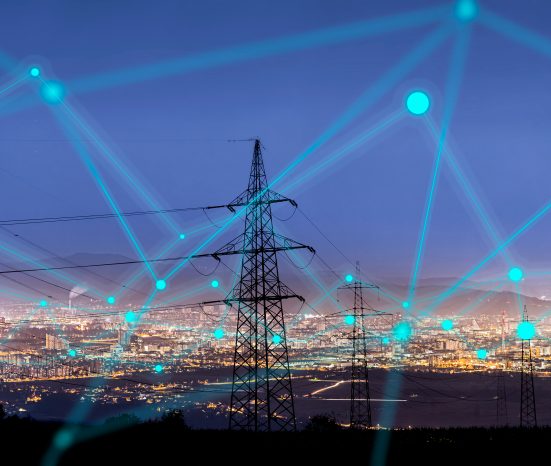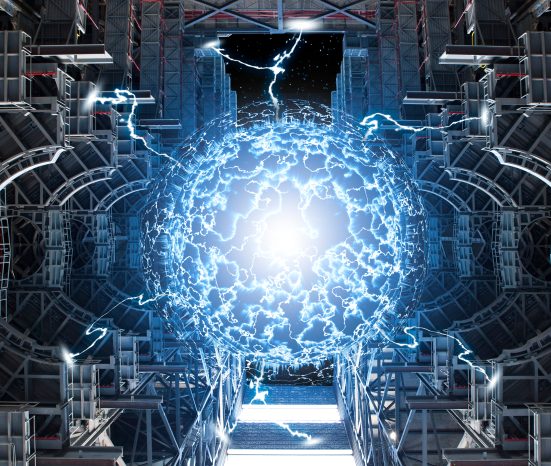Fusion Power
What is Fusion Power?
Fusion power is a proposed form of power generation that would produce electricity by utilizing heat from nuclear fusion reactions. In a fusion process, two lighter atomic nuclei combine to form a heavier nucleus, releasing energy in the process. Devices designed to harness this energy are known as fusion reactors. To achieve fusion, the fuel must be heated to extreme temperatures – around 15 million degrees Celsius in the centre of the Sun. This process is what powers the Sun and other stars, where hydrogen nuclei combine to form helium. Despite promising breakthroughs, large-scale nuclear fusion for practical energy production is still several years away.
A fusion reactor is designed to generate electricity by using heat from nuclear fusion reactions. Here is how it works:
- Fusion Process: In a fusion reaction, two lighter atomic nuclei (usually isotopes of hydrogen) combine to form a heavier nucleus, releasing energy in the process.
- Plasma Creation: Fusion reactors create a plasma – a hot, ionized gas – by heating the fuel to extremely high temperatures (around 100 million kelvins). This plasma allows fusion to occur.
- Confinement: The plasma must be confined for a sufficient duration to allow fusion reactions. Researchers use various confinement concepts, including tokamaks and inertial confinement by laser.
- Fuel Choice: Fusion reactors typically use heavy hydrogen isotopes like deuterium and tritium. These isotopes react more easily than regular hydrogen (protium) and allow reaching the necessary conditions for fusion.
- Safety and Challenges: Fusion has advantages over fission (used in nuclear power plants), such as reduced radioactivity, less nuclear waste, and abundant fuel. However, achieving the required temperature, pressure, and confinement time remains challenging.
- Current Research: Notably, the ITER tokamak in France, the National Ignition Facility (NIF) laser in the United States and the UK JET laboratory are researching fusion reactor designs.
Remember, while fusion holds great promise, no fusion device has yet achieved net power production, although net positive reactions have been achieved.
Fusion Power and the Aerospace Industry
Fusion power has several potential applications in the arospace industry:
- Spacecraft Propulsion: Fusion-powered spacecraft could achieve much higher speeds than conventional chemical rockets. The high energy density of fusion reactions would allow for efficient interplanetary travel. One concept is the fusion rocket, where a fusion reactor heats a propellant (such as hydrogen) to generate thrust. This could significantly reduce travel times for crewed missions to Mars, outer planets, and beyond.
- Electric Power Generation for Space Stations: Fusion reactors could provide a reliable and long-lasting power source for space stations, lunar bases, or Mars colonies. Unlike solar panels (which are less effective in deep space), fusion reactors would work consistently regardless of location or time of day.
- In-Situ Resource Utilization (ISRU): Fusion could power equipment for extracting resources from celestial bodies (e.g., the Moon or asteroids). For example, a fusion-powered drill could extract water ice from the Moon’s surface, which could then be split into hydrogen and oxygen for rocket fuel.
- Fuel Choice: Fusion reactors typically use heavy hydrogen isotopes like deuterium and tritium. These isotopes react more easily than regular hydrogen (protium) and allow reaching the necessary conditions for fusion.
- Radiation Shielding: Fusion reactors could generate magnetic fields that protect astronauts from harmful cosmic radiation during long space journeys. These magnetic shields would reduce health risks associated with prolonged exposure to space radiation.
- Nuclear Pulse Propulsion: Although not directly fusion power, nuclear pulse propulsion (using fusion bombs for propulsion) was once considered for interstellar travel. The idea was to detonate small fusion bombs behind a spacecraft, using the explosion to propel it forward. However, this concept has significant safety and environmental challenges.
- Deep-Space Exploration: Fusion-powered spacecraft could explore distant regions of the solar system, such as the Kuiper Belt or Oort Cloud. The ability to sustain fusion reactions for extended periods would enable missions lasting decades or even centuries./li>
Keep in mind that practical fusion power for aerospace applications is still under development. Researchers continue to work on achieving sustained fusion reactions and overcoming technical challenges. Once achieved, fusion could revolutionize space exploration and travel.
Evolution of Fusion Power

The evolution of fusion power began with scientific experiments in the early 20th century, aiming to replicate the energy-producing reactions that power the sun and stars. Significant milestones include the development of the tokamak design in the 1950s and the achievement of controlled nuclear fusion reactions in the 1970s. Since then, international collaborations such as ITER (International Thermonuclear Experimental Reactor) have focused on building larger and more advanced fusion reactors to demonstrate sustained fusion energy production. With ongoing research into materials science, plasma physics, and energy conversion technologies, fusion power holds promise as a clean and abundant energy source for the future.
Aerospace & Fusion Power in Future
In the future, fusion power could revolutionize the aerospace industry by providing a clean and abundant energy source for space missions and aircraft propulsion systems. Fusion reactors could potentially enable long-duration space missions by generating continuous and high-energy propulsion systems, reducing reliance on traditional fuels. Furthermore, fusion-powered spacecraft could reach distant planets more quickly and sustainably, opening up new possibilities for space exploration and colonization. However, achieving practical fusion power for aerospace applications requires overcoming significant technical challenges and advancing fusion reactor designs to be compact, efficient, and reliable in space environments.

Frequently Asked Questions
Common questions and answers pertaining to fusion power, especially in regards to aviation.
How does fusion power differ from conventional nuclear power in aviation applications?
Fusion power produces energy by fusing atomic nuclei at extremely high temperatures, unlike conventional nuclear fission which splits nuclei. Fusion promises cleaner energy with abundant fuel sources like hydrogen isotopes and reduced nuclear waste compared to fission.
Can fusion power be used for aircraft propulsion?
Fusion power has the potential for aircraft propulsion systems, offering high energy density and long-duration flight capabilities. However, current fusion reactor designs are large and complex, requiring significant advancements in miniaturization and efficiency for practical aviation use.
What are the benefits of fusion power for aviation and aerospace?
Fusion power could provide sustainable and efficient energy sources for long-duration flights and space missions, reducing dependence on traditional fuels and lowering carbon emissions. It also promises continuous and reliable energy production, crucial for extended missions beyond Earth’s atmosphere.
What challenges does fusion power face in aviation adoption?
Challenges include developing compact and efficient fusion reactors suitable for aircraft integration, ensuring safety and reliability in high-altitude and variable atmospheric conditions, and addressing regulatory and certification requirements for new propulsion technologies.
What is the timeline for integrating fusion power into aviation and aerospace applications?
Practical integration of fusion power into aviation is currently speculative, with significant research and development needed to demonstrate feasibility and overcome technical hurdles. Estimates vary widely, but practical fusion-powered aircraft could potentially be realized in several decades pending technological advancements and regulatory approvals.
Video Explanation
The video below will provide more information as to how this technology works
Example Industry User

Tokamak Energy is at the forefront of developing fusion power technology, aiming to create a clean and sustainable energy source. By advancing tokamak design, they seek to achieve practical and efficient nuclear fusion, which involves fusing atomic nuclei to release energy, mimicking the processes occurring in the sun. Tokamak Energy focuses on compact spherical tokamaks and high-temperature superconductors to enhance the feasibility and cost-effectiveness of fusion reactors. Their efforts are pivotal in the quest to harness fusion power as a viable solution for global energy needs, promising an abundant and environmentally friendly energy source.
Further Resources
Below are some external links to further information on this technology.



